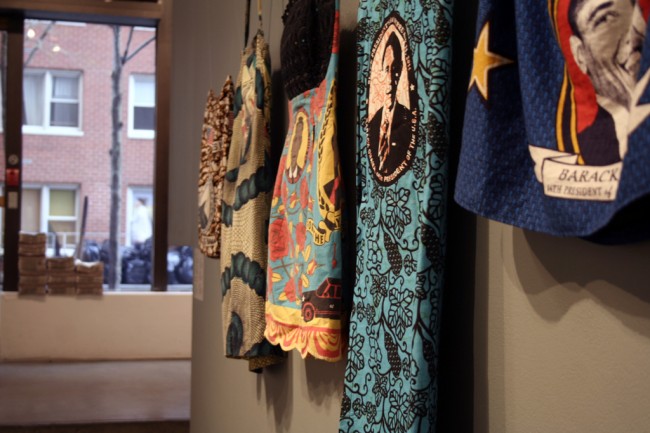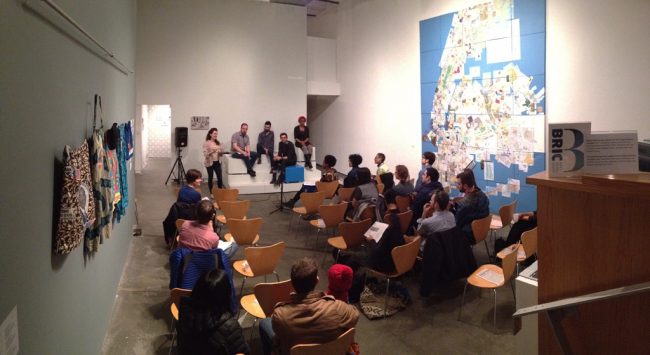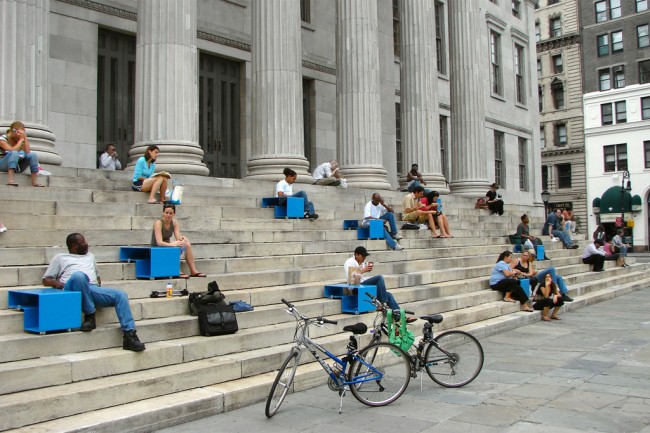
We are celebrating 15 years — and counting — of stories that are deeply researched and deeply felt, that build a historical record of what the city has been.
We are celebrating 15 years — and counting — of stories that are deeply researched and deeply felt, that build a historical record of what the city has been.

Skirts from Aisha Cousins’ from here I saw what happened and I could not understand (aka The Obama Skirt Project) | Image by Erin Gleason
In exhibiting art, galleries — whether the vaunted spaces of Chelsea or an obscure room on the outer reaches of Bushwick — can be painfully isolating. The shows often have a narrow focus on pieces, the context of which can go unexplained beyond a year printed on a placard alongside an artist’s name and a title. Cultural Fluency: Engagements with Contemporary Brooklyn, an exhibition on view at the BRIC Rotunda Gallery through April 27th, provides a different approach. Rather than understood as distinct artifacts, the pieces, refreshingly, are pegged as products of a specific place and time rather than simply the creations of a lone artist.
The environment that exhibition curator Erin Gleason has created by placing these pieces into conversation at BRIC mirrors a Brooklyn that birthed both the works and the gallery itself. Upon entering, I first noticed a stoop toward the back of the space that seemed to be a prime viewing locale. To the right, a towering map of the city, the ubiquitous shape that structures our trips from place to place and charts the neighborhoods that we know only through hearsay, offered an immediate introduction to the geographic focus of the show. Turning toward the entrance, I watched the liveliness of the street displayed in a video of public song and, on the next wall, caught sight of a string of hanging clothes that would otherwise be moving on bodies through the streets. Further off to the side, photographs of an old theater give the visitor a sense of peering though a dusty window into a building bordering the gallery’s mimicked street. All this is surrounded by walls almost imperceptibly tagged with a few phrases, graffiti sterilized in the grey and white cleanliness of the gallery.
The pieces, each of which takes spaces across Brooklyn as inspiration or subject, begin an exploration of the dialogue between community and artist intended to have legs far beyond the gallery. Surely, this dialogue is not new. Gleason takes the exhibition’s name from conceptual artist Joseph Kosuth’s 1975 essay “The Artist as Anthropologist,” in which Kosuth speaks of the reciprocal relationship between the artist and culture, whereby the artist is both attempting to affect culture while that culture in turn affects the artist. He terms this process an exercise in obtaining cultural fluency. This fluid interchange between artist and place is not only exhibited in each piece. By interpreting the city in art form, the artist extends this dynamic to the viewer by providing a new perspective from which to perceive the community, in turn potentially affecting how that viewer interacts with the city going forward.
The exhibited projects all have a performative or public quality, which a display in the glowing white box of the gallery fails to fully capture. This failure is intentional and instructive. As Gleason explains, “All of the artworks are defined by distinct moments, impossible to replicate in form and cultural exchange.” Though most of the works are not particularly suited for the gallery, the collection is accompanied by a newspaper, filled with texts and transcribed conversations, that contextualizes and animates the works outside of their intended habitats: the street, store, or public square.

Exhibition curator Erin Gleason poses questions to the artists at the Q&A | Photo by Abigail Clarke, courtesy of BRIC Arts | Media | Bklyn
I was privy to an enhanced explanation of this larger context during a recent question and answer session with the artists and curator at the BRIC space. Mark Reigelman, the artist behind Stair Squares — a public art piece made up of metal squares molded to mirror and interlock with the steps of Brooklyn Borough Hall, which also acts as a table for sitters — reiterated that the only true home for his piece was Brooklyn Borough Hall. The gallery piece, three squares set atop a stoop constructed to the specifications of its permanent cousin down the street, primarily served as a point of departure for a discussion of the effect of Stair Squares during its two-week public installation in 2008. The interaction between lunchtime crowds and the squares, to Reigelman, was the true artwork. Reigelman recalled the evolving relationship between the public and the piece: people first assessing the installation, then moving on to full and diverse utilization of the structure as a perch for coffee, an armrest, book stand, or storage space.
Martin McCormack’s piece, The Great New York City Mapping Project, also serves as a representation of a project that exists more completely outside of the exhibition. McCormack has spent the last three years collecting maps, be they small as a business card or extensive as a zoning map, to construct a much larger and significantly textured depiction of the city. He simply walks around neighborhoods, stopping in at businesses to see what they have, picking and choosing from the ubiquitous and the obscure. This process is arguably the much more interesting piece. This physical representation of the city — including Brooklyn — displays the many worlds that overlap to create the whole, the various features of our places deemed important by different cartographers, and the widely differing scales from which one can assess space. And just as the city changes, so does the map — as McCormack comes in contact with new places and worlds within it, he fills in unmapped areas and adds nuance and diversity to already densely plotted places.
Two performance works, displayed in very different ways, were also particularly interesting. In 2010, Malesha Jessie, an opera singer, staged impromptu concerts in spaces across Bedford-Stuyvesant not usually home to such “high” art, among them bodegas and barbershops. Her performances and the resulting interactions with spectators, collectively named Guerilla Opera, are displayed in a short video played on a loop. What distinguishes Jessie’s work from prankster culture or mere spectacle is the intention to showcase an art traditionally siloed off from public spaces and people that inspire and inform new work and performance. Removing these barriers and forthrightly sharing talent outside the protective padding of a performing arts institution produces reactions that, whether they are marked by disregard, humor, or awe, are striking in their lack of filter.
Though less animated within the gallery, Aisha Cousins’ work from here I saw what happened and I could not understand (aka The Obama Skirt Project) is a highly dynamic public performance. Cousins wore traditional African fabrics bearing Barack Obama’s image each day for a year from July 2009 through 2010, partially as a personal experiment in how doing so would affect her own perception of the first black president, but also as an exercise in the public’s interaction with her soon after his inauguration. Rather than document the project through video or photographs, Cousins produced scripts representative of her experience that continue to be performed by others, including a group of Brooklyn women called the Bed-Stuy Story Skirters. At BRIC, one of these scripts is tacked to the wall alongside some of the garments bearing the President’s visage. These stand-ins do not do the project justice. They do however provide a reminder of the performance of everyday life, sketched out in everything from clothing to the reactions and interactions we have to our environment.

Stair Squares in use on the steps of Brooklyn Borough Hall in 2008 | Photo by Mark Reigelman, courtesy of BRIC Arts | Media | Bklyn
While the exhibition does not attempt and could not be expected to temporarily encapsulate or define the many layers and interpretations of Brooklyn scattered across the borough, it does display an interesting taste of the intersection between urbanism and art. In the Q&A, Gleason made clear that the grouping was just the beginning of a further examination of the relationship between art and place in the city, which will for now be continued through interviews with other cultural actors on the Cultural Fluency blog. I hope that future gallery installations at BRIC — or elsewhere — offer a similar framework, an exhibition that seeks to mark and make important the place from which the pieces originate.
Cultural Fluency — featuring work by David Court, Aisha Cousins, Malesha Jessie, Hiroki Kobayashi, Martin McCormack, and Mark Reigelman — is on view through April 27th from 12pm – 6pm Tuesday through Saturday at the BRIC Rotunda Gallery in Brooklyn Heights. Admission is free.
All images courtesy of BRIC Arts | Media | Bklyn.
The views expressed here are those of the authors only and do not reflect the position of The Architectural League of New York.